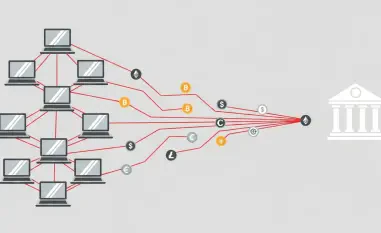FunkSec, a relatively new player in the cybercrime arena, has been making waves with its aggressive tactics and use of AI. Emerging in October 2024, this ransomware-as-a-service (RaaS) group has quickly gained notoriety. But is FunkSec a genuine ransomware threat, or are they merely hacktivists leveraging AI to amplify their impact?
FunkSec’s Emergence and Early Activities
Introduction to FunkSec
FunkSec made its debut on the Breached forum in October 2024, rapidly establishing its presence with a data leak site by December of the same year. The group’s aggressive approach has been marked by the posting of 85 claimed victims within its first month of operation. This rapid activity has drawn significant attention from cybersecurity experts and the media, who are keen to understand the true nature and capabilities of FunkSec in the cybercrime landscape.
Despite their swift emergence, the validity of FunkSec’s claims remains under scrutiny. The sheer number of purported leaks in such a short span raises questions about their authenticity and the actual reach of FunkSec’s operations. As a new RaaS group, their sudden rise to prominence suggests a calculated effort to project a formidable image rather than evidence of substantial cybercrime proficiency. This projection, fueled by aggressive marketing on cybercrime forums and social media, seems to be a deliberate strategy to establish themselves as a new threat players must recognize and address.
AI-Generated Notoriety
One of FunkSec’s initial high-profile actions was the purported release of a leaked call between U.S. presidential candidate Donald Trump and Israeli Prime Minister Benjamin Netanyahu. However, cybersecurity experts quickly identified the conversation as AI-generated, highlighting FunkSec’s unique strategy of using sophisticated AI tools to create a buzz and gain notoriety. This approach, although innovative, indicates a reliance on technology to fabricate events and manipulate public perception.
The incident underscores FunkSec’s attempt to leverage AI in its operations, aiming to blur the lines between reality and artificiality. By generating such high-profile but fake content, FunkSec seeks to position itself as a significant player in the cybercrime sphere. This reliance on AI for generating high-impact content suggests that while the group possesses some level of technical expertise, they might lack the traditional skills and experience often associated with more established cybercriminal entities.
Hacktivist Roots and Questionable Proficiency
Recycling Old Data
A deeper dive into FunkSec’s operations reveals that many of their claims, including the supposed 85 victims, appear to be recycled from older hacktivism campaigns. This recycling of data, rather than indicating new breaches, highlights FunkSec’s propensity to reuse information to build their reputation. Such tactics cast doubt on FunkSec’s proficiency and experience as a genuine ransomware threat entity, suggesting a pattern consistent with their hacktivist origins and beginner-level cybercrime strategies.
The recycling of older data points to a rather amateurish approach, inconsistent with the behavior of sophisticated ransomware groups. It suggests that FunkSec might be more focused on creating a facade of menace by repackaging existing information rather than executing significant new attacks. This strategy, while boosting their profile in the cybercriminal community, also hints at underlying limitations in their technical capabilities and the novelty of their operations.
Connections to Ghost Algéria
Further analysis by Check Point Research has unveiled connections between FunkSec and Ghost Algéria, a now-defunct hacktivist group. This link was established through nearly identical ransom notes used by both groups, reinforcing FunkSec’s hacktivist roots and raising questions about their evolution into a ransomware entity. The parallel between the two groups’ communication methods and ransom demands underscores an underlying continuity in their operational methodologies and objectives.
These connections further cast a shadow on FunkSec’s legitimacy and expertise as a formidable ransomware group. Missteps by the group, such as publicly sharing their location in Algeria through screenshots and posting basic questions on cybercrime forums, highlight their amateurish nature. Such actions demonstrate a lack of professionalism and technical acumen, undermining their purported image as a significant ransomware threat. Instead, these behaviors suggest that FunkSec might still be grappling with the fundamentals of cybercrime, relying heavily on their hacktivist background.
Technical Aspects of FunkSec’s Ransomware
Inefficiencies in Code
On the technical side, FunkSec’s ransomware displays significant redundancy within its code, often calling functions multiple times in an inefficient manner. Such coding practices indicate a lack of refined development skills that are typically seen in advanced ransomware operations. This amateurish approach to coding further questions their sophistication and challenges their ability to be seen as a genuine ransomware threat.
The ransomware’s technical shortcomings suggest that despite their use of advanced AI tools for notoriety, FunkSec lacks the deep programming expertise required to develop sophisticated, streamlined malware. These redundancies and inefficiencies in their code highlight a reliance on brute-force methods rather than advanced techniques, a hallmark of seasoned cybercriminal groups. Such technical limitations reinforce the notion that FunkSec might be more about image and less about substantial cybercrime prowess.
Additional Tools and Capabilities
In addition to their ransomware, FunkSec markets various tools such as a Python-based distributed denial-of-service (DDoS) tool, a password generation and scraping tool, and a remote desktop management tool. These tools, while indicative of their broader cybercrime activities, also reflect their reliance on accessible, off-the-shelf technologies rather than advanced, custom-developed solutions. This dependence on commonly available tools suggests that FunkSec might lack the capability to develop unique, sophisticated cybercrime toolsets.
The array of tools offered by FunkSec hints at their ambition to cover a broader spectrum of cybercrime activities. However, the reliance on accessible technologies instead of developing advanced tools internally further underscores their limitations. This strategy possibly aims at maximizing their reach and impact with minimal investment in sophisticated development resources, leveraging readily available solutions to engage in various forms of cybercrime, from DDoS attacks to password theft.
AI’s Role in FunkSec’s Operations
Custom Chatbot and AI Summaries
AI plays a crucial role in FunkSec’s operations, from the creation of content to the enhancement of their cybercrime activities. Insights reveal the use of a custom chatbot designed through the Miniapps platform and summaries generated by ChatGPT to describe their ransomware capabilities. This reliance on AI tools for crafting parts of their malware indicates a strategic use of technology to mask their lack of sophistication while attempting to project a more advanced cybercriminal identity.
The use of AI highlights FunkSec’s innovative approach in the cybercrime domain. By leveraging sophisticated AI tools, they aim to enhance their operational effectiveness and create a perception of advanced capabilities. This strategy, while effective in creating notoriety and confusion, also points to an underlying lack of traditional technical skills. The reliance on AI-generated content and summaries suggests that FunkSec is adept at using modern technological solutions to amplify their impact, despite limited inherent expertise.
Contradictions in Language Proficiency
A notable aspect of FunkSec’s reliance on AI is the stark contrast between the detailed comments written in proficient English within the publicly available code and the poor English displayed by FunkSec’s members in other contexts. This discrepancy suggests a heavy dependence on AI tools for crafting technical descriptions and communication, further highlighting their reliance on accessible technologies to enhance their operations artificially.
This language proficiency contradiction underscores FunkSec’s strategic use of AI to bridge gaps in their capabilities. While AI-generated content can create an illusion of expertise and professionalism, the inconsistency in individual members’ language skills betrays their reliance on technology. This dependence on AI tools not only enhances their external image but also reveals underlying vulnerabilities. The group’s actual technical skills and expertise are significantly lower than what their public-facing materials might suggest.
FunkSec’s Economic Model and Target Base
Low Ransom Demands
FunkSec’s ransomware, which is frequently updated, claims low detection rates by antivirus services, with the latest version, FunkSec V1.5, showcasing these features. Unusually low ransom demands characterize FunkSec’s economic model, suggesting that their strategy aims at maximizing compliance and payment frequency rather than pursuing fewer, higher-value targets. This approach indicates a volume-based strategy, possibly designed to est













